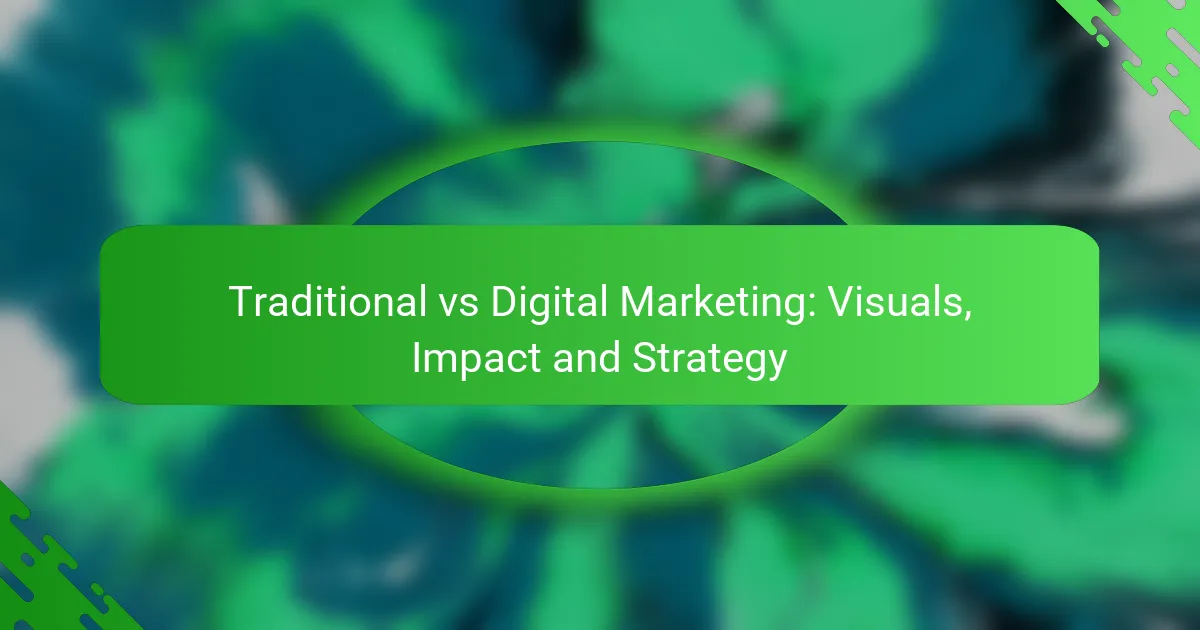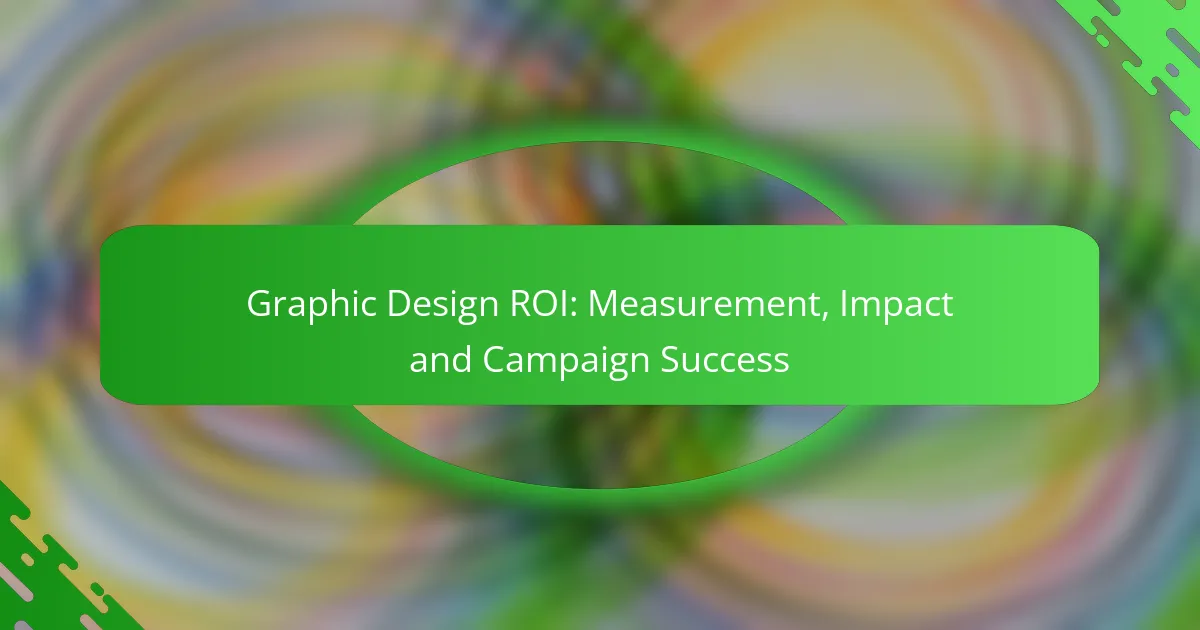In the evolving landscape of marketing, traditional and digital approaches each offer unique advantages that can significantly impact e-commerce strategies. While traditional marketing builds local connections and brand trust through static visuals and community engagement, digital marketing leverages dynamic content and real-time interaction to reach a global audience. Understanding the strengths of both methods is essential for crafting effective campaigns that resonate with diverse consumer bases.
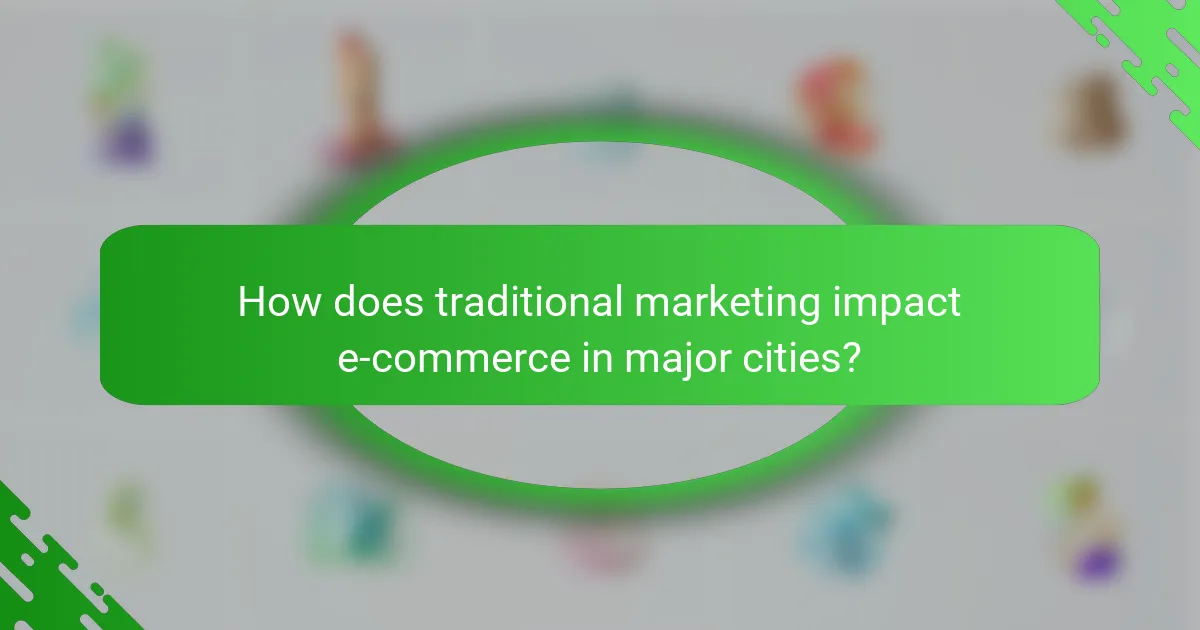
How does traditional marketing impact e-commerce in major cities?
Traditional marketing significantly influences e-commerce in major cities by enhancing brand visibility and fostering local connections. Tactics such as print advertising, community events, and sponsorships can create trust and recognition, driving online sales and customer loyalty.
Brand awareness through print media
Print media, including newspapers, magazines, and brochures, plays a crucial role in establishing brand awareness for e-commerce businesses. In densely populated urban areas, targeted print campaigns can reach specific demographics effectively, often leading to higher engagement rates compared to digital-only strategies.
For instance, a local fashion retailer might place ads in city magazines or distribute flyers in neighborhoods to attract potential customers. This approach can complement online efforts, reinforcing the brand’s message across multiple channels.
Local community engagement
Engaging with the local community is essential for e-commerce brands looking to build a loyal customer base. Traditional marketing methods, such as hosting workshops or participating in local fairs, allow businesses to connect with residents and showcase their products in a tangible way.
For example, an e-commerce food delivery service could sponsor a local farmers’ market, offering samples and discounts to attendees. This not only boosts brand visibility but also fosters a sense of community, encouraging repeat business.
Event sponsorship effectiveness
Sponsoring local events can be a powerful way for e-commerce businesses to enhance their presence in major cities. By aligning with community events, brands can gain exposure to a targeted audience while demonstrating their commitment to local culture.
Effective sponsorships might include supporting charity runs, art festivals, or sports events. These opportunities allow brands to showcase their products and engage directly with potential customers, often resulting in increased website traffic and sales conversions.
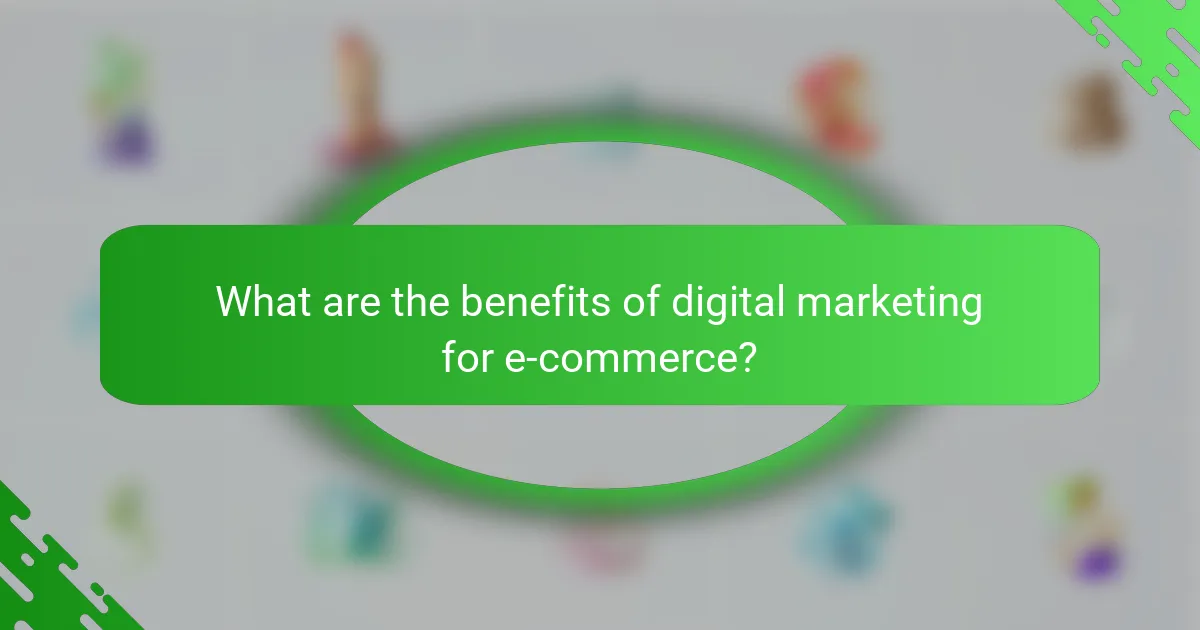
What are the benefits of digital marketing for e-commerce?
Digital marketing offers e-commerce businesses the ability to reach a global audience, engage with customers in real-time, and analyze performance metrics effectively. This approach enhances brand visibility and drives sales through targeted strategies that traditional marketing methods often lack.
Targeted advertising capabilities
Digital marketing enables e-commerce businesses to create highly targeted advertising campaigns based on user behavior, demographics, and interests. Platforms like Google Ads and Facebook Ads allow for precise audience segmentation, ensuring that marketing messages reach the most relevant potential customers.
For example, a clothing retailer can target ads specifically to users who have previously shown interest in fashion, increasing the likelihood of conversion. This level of targeting is not typically achievable with traditional marketing methods, which often cast a wider net.
Real-time performance analytics
One of the key advantages of digital marketing is the ability to track and analyze campaign performance in real-time. E-commerce businesses can monitor metrics such as click-through rates, conversion rates, and customer engagement immediately, allowing for quick adjustments to strategies.
Tools like Google Analytics provide insights into user behavior on e-commerce sites, helping businesses understand which products are popular and which marketing tactics are effective. This data-driven approach enables continuous improvement and optimization of marketing efforts.
Cost-effectiveness compared to traditional methods
Digital marketing is generally more cost-effective than traditional marketing methods, such as print or television advertising. E-commerce businesses can often achieve a higher return on investment (ROI) with lower upfront costs, making it accessible for companies of all sizes.
For instance, running a social media ad campaign can cost significantly less than producing a television commercial while still reaching a large audience. Additionally, digital marketing allows for flexible budgeting, enabling businesses to scale their efforts based on performance and available resources.
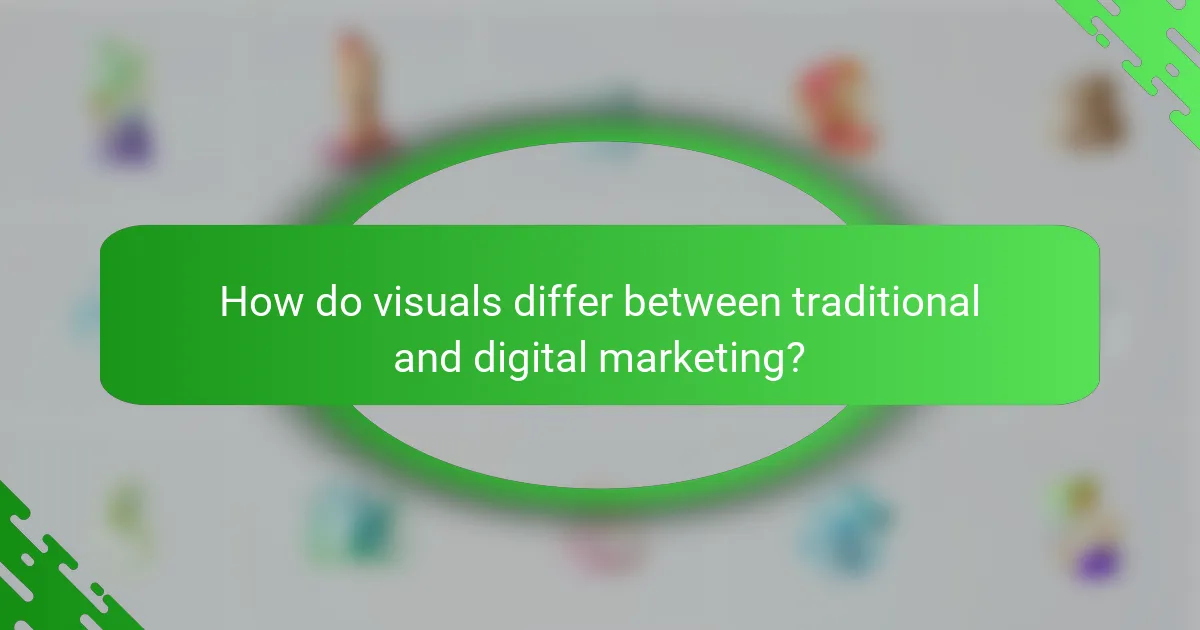
How do visuals differ between traditional and digital marketing?
Visuals in traditional marketing are typically static, relying on print media like brochures and billboards, while digital marketing employs dynamic visuals that can engage users through interactivity and multimedia elements. Understanding these differences is crucial for developing effective marketing strategies that resonate with target audiences.
Static vs. dynamic content
Static content refers to unchanging visuals, such as images or text in print ads, which convey a fixed message. In contrast, dynamic content can adapt based on user interaction, such as animated graphics or videos on websites and social media platforms. This interactivity allows for a more engaging user experience, increasing the likelihood of audience retention and conversion.
When creating marketing materials, consider the context in which they will be viewed. Static content is often more suitable for long-lasting impressions, while dynamic content can capture attention quickly and encourage immediate action.
Use of multimedia in digital campaigns
Digital marketing campaigns frequently incorporate various multimedia elements, including videos, audio, and interactive graphics, which enhance storytelling and brand messaging. For instance, a video ad can convey complex ideas more effectively than a static image, appealing to both visual and auditory learners.
Utilizing multimedia can significantly boost engagement rates. Brands should aim to include a mix of formats, such as short clips for social media and longer videos for websites, to cater to different audience preferences and platforms.
Print design limitations
Print design is constrained by physical dimensions and production costs, limiting the complexity and variety of visuals that can be used. For example, colors may appear differently in print than on screens, and intricate designs can be expensive to produce in large quantities.
Marketers should keep these limitations in mind when designing print materials. Simple, bold designs often work best, ensuring that key messages are clear and impactful. Additionally, consider the target audience’s preferences and how they interact with printed materials to maximize effectiveness.
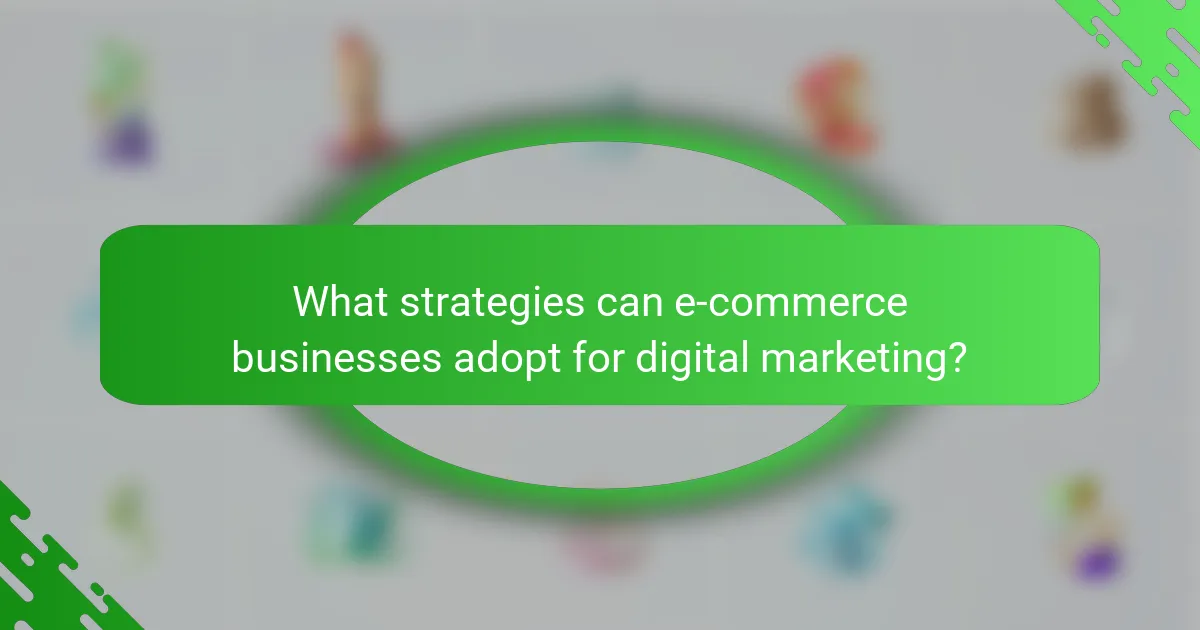
What strategies can e-commerce businesses adopt for digital marketing?
E-commerce businesses can adopt various digital marketing strategies to enhance their online presence and drive sales. Key approaches include leveraging search engine optimization, engaging customers through social media, and personalizing email marketing campaigns.
Search engine optimization techniques
Search engine optimization (SEO) techniques are essential for improving visibility on search engines. Businesses should focus on keyword research to identify relevant terms that potential customers use, optimizing website content accordingly.
On-page SEO elements, such as meta tags, headers, and image alt texts, play a crucial role in ranking. Additionally, consider off-page strategies like building backlinks and improving site speed to enhance user experience and search rankings.
Social media engagement tactics
Social media engagement tactics involve creating interactive content that resonates with your audience. Regularly posting updates, promotions, and behind-the-scenes content can foster community and encourage sharing.
Utilizing platforms like Instagram and Facebook for targeted ads can effectively reach specific demographics. Engaging with followers through comments and direct messages also builds relationships and enhances brand loyalty.
Email marketing personalization
Email marketing personalization is vital for increasing open and conversion rates. Segmenting your email list based on customer behavior or preferences allows for tailored messages that resonate more with recipients.
Incorporate personalized subject lines, product recommendations, and special offers to enhance engagement. Regularly analyze campaign performance to refine strategies and ensure messages align with customer interests.
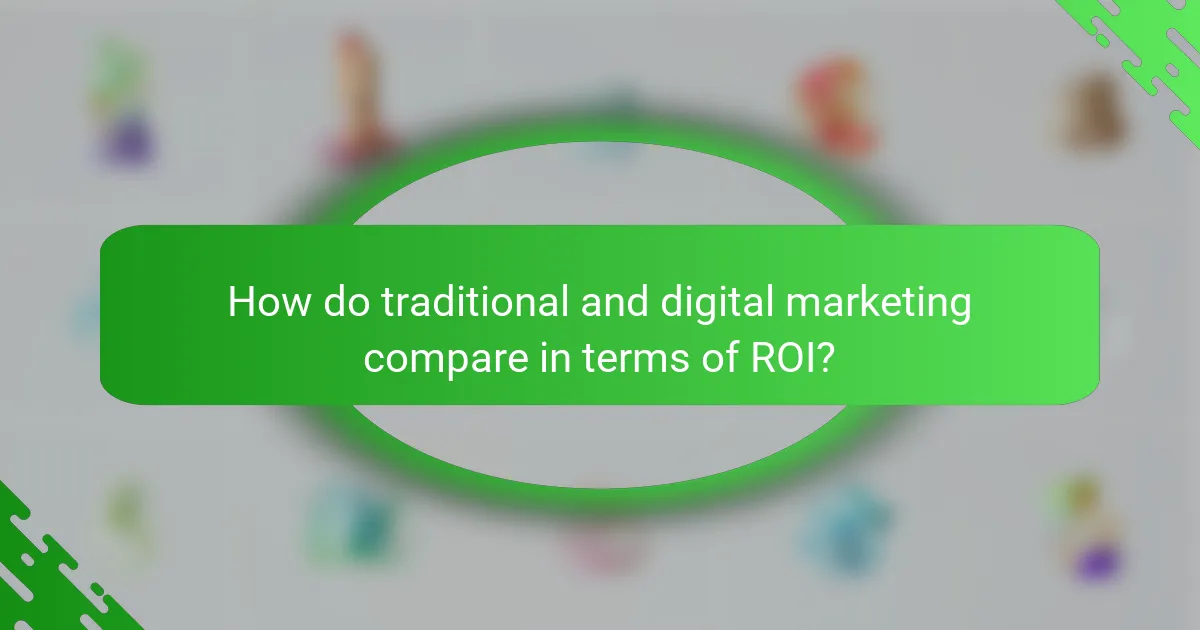
How do traditional and digital marketing compare in terms of ROI?
Traditional and digital marketing offer different returns on investment (ROI) based on their strategies and execution. Digital marketing typically allows for more precise tracking of results, while traditional marketing can build long-term brand loyalty.
Measurable results in digital marketing
Digital marketing excels in providing measurable results through analytics tools that track user engagement, conversion rates, and campaign performance. Marketers can easily assess which channels yield the highest ROI, enabling them to allocate budgets more effectively.
For example, a business running a pay-per-click (PPC) campaign can see immediate data on clicks and conversions, allowing for quick adjustments. This real-time feedback loop is a significant advantage over traditional methods, where results may take weeks or months to evaluate.
Long-term brand loyalty from traditional marketing
Traditional marketing strategies, such as print ads and television commercials, can foster long-term brand loyalty by creating a strong emotional connection with consumers. These methods often rely on storytelling and brand narratives that resonate over time.
For instance, a well-placed television ad during a popular event can leave a lasting impression, encouraging repeat purchases. While traditional marketing may not provide immediate metrics, its impact on brand perception and customer loyalty can be profound, often translating into sustained revenue over the long term.
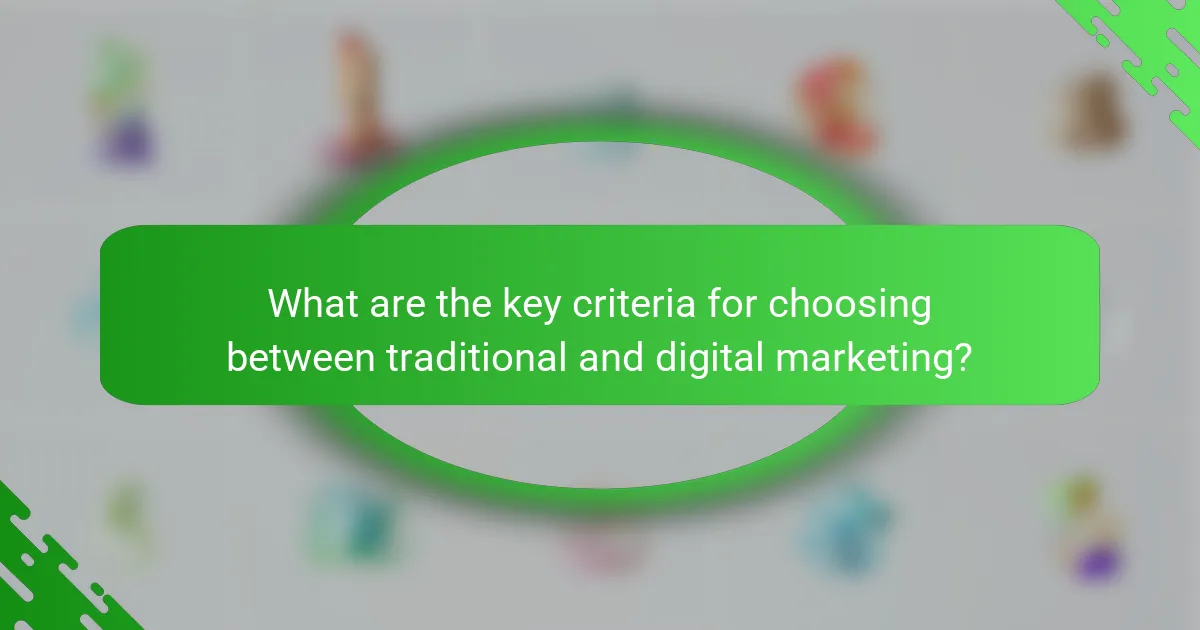
What are the key criteria for choosing between traditional and digital marketing?
Choosing between traditional and digital marketing depends on factors like target audience, budget, and campaign goals. Each method has distinct advantages and drawbacks that can significantly impact effectiveness and reach.
Visuals in Traditional Marketing
Traditional marketing often relies on physical visuals such as print ads, billboards, and brochures. These visuals can create a strong local presence and are tangible, which can enhance brand recall. However, they may lack the dynamic and interactive qualities that digital visuals offer.
For example, a well-designed billboard can attract attention in high-traffic areas, while a brochure can provide detailed information that consumers can take home. The downside is that these materials can be costly to produce and distribute, and they have limited tracking capabilities.
Visuals in Digital Marketing
Digital marketing utilizes visuals like images, videos, and infographics across platforms such as social media, websites, and email. These visuals can be easily updated and tailored to specific audiences, allowing for greater engagement. Additionally, digital visuals can be optimized for various devices, enhancing user experience.
For instance, a compelling video ad on social media can go viral, reaching a wide audience at a fraction of the cost of traditional media. The ability to analyze engagement metrics in real-time also allows marketers to adjust their strategies quickly.
Impact of Traditional Marketing
Traditional marketing can have a significant impact, particularly in local markets. It often fosters trust through established channels like television and radio, which many consumers still rely on. Campaigns can reach demographics that may not be as active online.
However, the impact can be difficult to measure, and the return on investment (ROI) may not be as clear-cut as with digital methods. Businesses should consider their audience’s media consumption habits when evaluating the potential impact of traditional marketing.
Impact of Digital Marketing
Digital marketing generally offers a broader reach and more precise targeting capabilities. It allows businesses to engage with consumers in real-time, fostering immediate interactions and feedback. The ability to track metrics such as click-through rates and conversions provides valuable insights into campaign effectiveness.
Moreover, digital marketing can be more cost-effective, especially for small businesses. With options like pay-per-click advertising, companies can control their budgets and only pay for actual engagement.
Strategy Considerations for Traditional Marketing
When developing a strategy for traditional marketing, businesses should focus on their target audience and the best channels to reach them. Consider the timing and placement of ads to maximize visibility and impact. Collaborating with local businesses or events can also enhance outreach.
It’s essential to allocate a budget that considers production and distribution costs. Regularly evaluate the effectiveness of campaigns to ensure they meet objectives and adjust strategies as necessary.
Strategy Considerations for Digital Marketing
For digital marketing, a well-defined strategy is crucial. Start by identifying key performance indicators (KPIs) that align with business goals, such as website traffic, lead generation, or sales conversions. Utilize tools like social media analytics and SEO metrics to inform your strategy.
Engagement is vital in digital marketing, so focus on creating compelling content that resonates with your audience. Regularly update your campaigns based on performance data to optimize results and ensure you are meeting your targets effectively.
